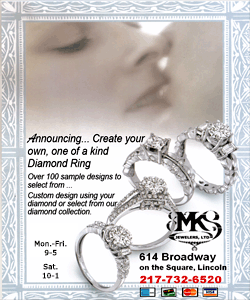|
 The Springfield Watch Company was organized in 1869 and soon
became the largest employer not only on the North Side, but in all
of Springfield. In 1878 under the leadership of Jacob Bunn as
president the factory took the name Illinois Watch Company. The
factory became the center of much of Springfield life on the North
Side and the owners were known for their progressive employee
practices, including support for an Illinois Watch Factory band. The
band’s original drum is on display in this exhibit. The Springfield Watch Company was organized in 1869 and soon
became the largest employer not only on the North Side, but in all
of Springfield. In 1878 under the leadership of Jacob Bunn as
president the factory took the name Illinois Watch Company. The
factory became the center of much of Springfield life on the North
Side and the owners were known for their progressive employee
practices, including support for an Illinois Watch Factory band. The
band’s original drum is on display in this exhibit.
Time after time, the Company excelled in engineering and
manufacturing and made a name for itself in the industry. One
example of such recognition was the adoption of the Illinois Watch
Factory railroad pocket watch as the official American railroad
watch because it was the most accurate. By 1907, the Company was
making wristwatches for women. With the arrival of WWI, it became
necessary for airplane pilots to use something other than a pocket
watch and it became the badge of a pilot to wear a wristwatch made
by the Illinois Watch Factory.

The Illinois Watch Company was one of Springfield’s largest
employers when Hamilton Watch Co. of Pennsylvania bought them out in
1927. The factory closed in Springfield in 1932. Illinois watches
continued to be made in Pennsylvania until 1939. Sangamo Electric
bought the watch factory buildings and continued making meters,
sonar equipment and eventually data processing equipment.
Sangamo Electric was created in 1899 as a separate company but on
the same grounds as the watch factory. They made the clocks that
dazzle one of the walls of the exhibit area. The clocks were
marketed as electrically wound and were guaranteed to run 24 hours
even if the unpredictable electricity of the day went off.
The beautiful and unique Lincoln-era Speldua wall clock is also a
part of the exhibit as are photos of company gatherings over the
years and advertising ephemera.
The history of the Illinois Watch Company contains three distinct
institutional chapters.
First: The Springfield Watch Company. The corporation was
established as the Springfield Watch Company by John C. Adams of
Massachusetts, and John Todd Stuart, William B. Miller, Dr. George
Pasfield, John Whitfield Bunn, John Williams, and George N. Black,
all of Springfield, Illinois. John Todd Stuart served as the first
President of the new corporation, which had been capitalized
initially at $100,000.00. William B. Miller served as the first
Secretary. The other named men constituted the original Board of
Directors of the Springfield Watch Company. By the end of the year
1872, the corporation had sold approximately 10,000 watch movements.
Second: The Illinois Springfield Watch Company. The
Springfield Watch Company encountered severe financial difficulty
during its institutional infancy. Consequently, the corporation had
to undergo reorganization in 1877. In July, 1877, the corporation
changed its name to the "Illinois Springfield Watch Company."
Erastus Newton Bates, the second President of the corporation,
assumed the chief executive leadership of the newly reorganized
concern until July, 1878. The corporation again faced severe
financial crisis, and had to be reorganized.

Third: The Illinois Watch Company. The Illinois Springfield
Watch Company was reorganized in the autumn and winter of 1878, and
was renamed the "Illinois Watch Company" (the final name of the
corporation). Chief executive leadership of the corporation was
assumed by Jacob Bunn, Sr. (1814–1897), an Illinois industrialist,
railroad financier, railroad reorganizer, wholesale grocer,
commission merchant, newspaper publisher, land developer, coal
operator, political advisor and financier, banker, and rope
manufacturer. Jacob Bunn was the older brother of John Whitfield
Bunn, and both men were among the closest friends and political
allies of Illinois lawyer and statesman Abraham Lincoln, whose
political career was largely financed and managed by the Bunn
brothers. Jacob Bunn, Sr., oversaw the steady growth of the new
corporation, and under his administration the corporate employment
grew from 260 in the year 1879 to 400 in the year 1880. Jacob Bunn
led corporate sales along a certain and definite trajectory of
growth in both volume of manufacture and corporate revenue. In 1879,
the corporation manufactured 33,285 watch movements. In 1880, the
corporation manufactured 47,065 watch movements. The corporation
helped pioneer the logistical technology that served the enforcement
of standard time for railroads throughout the world. At its apex of
profitability, the Illinois Watch Company employed approximately
1,200 people. Management
Principal Corporate Governance of the Illinois Watch Company: 1.
Jacob Bunn (1814–1897): President, reorganizer, Director, Chairman.
2. John Whitfield Bunn (1831–1920): Vice-President, Director. 3.
Charles Smorowski: Secretary of the corporation. 4. Jacob Bunn, Jr.
(1864–1926): Vice-President, President, Director, Chairman. 5. Henry
Bunn: Vice President, President, Director, Chairman. 6. Benjamin
Hamilton Feguson: Director, Vice-Chairman, Chairman. 7. Frederic W.
Morgan: General Cashier, Credit Manager. 8. Julius Armbruster:
General Salesman.
[to top of second column] |

The passing of Jacob Bunn, Jr. threw Illinois Watch into disarray.
In 1928, for a sum in excess of $5,000,000, the Illinois Watch
Company was purchased by the Hamilton Watch Company of Lancaster,
Pennsylvania, which continued to operate the factory under the
Illinois name and shifted the emphasis from pocket to wrist watch
production. By 1932, the Great Depression forced Hamilton to close
the Illinois factory, though they retained possession of the name
for many years. The Illinois Watch Company is now in Quincy
Illinois.
Wristwatches
Illinois Watch Company had four basic "periods" of wrist watch
production. The first period was from the 1910s to the early 1920s,
during which most wrist watches were converted pocketwatch
movements. Gent's military and military-style specimens were made,
often featuring porcelain dials.
The second period—from the early to mid-1920s—included movements and
dials which were sold to be cased by individual jewelers. These were
mostly small 6/0-size movements with 6:00 or 9:00 subsidiary
seconds. Some were also cased at the factory using generic cases
from a variety of sources. Some of the better-known models from that
latter category include the Square, Canby, Square Cut Corner,
Cushion, and Whippet. Also, larger 3/0-size movements were cased at
the factory in this way—the Champion, Special, Ace/Maxine, and
Atlantic, for example.
In the late 1920s, shortly before the Hamilton Watch Company took
over, Illinois began commissioning its own unique wrist watch cases.
The company cased and boxed its watches at the factory, marking the
beginning of what many collectors consider the company's golden era,
during which the finest watches were made. Models include the
Picadilly, Major, Marquis, Chieftain, Ritz, New Yorker and Manhattan
(the New Yorker came with a leather strap, the Manhattan with a
metal one), Jolly Roger, Viking, Wembley/Medalist, Speedway,
Guardsman, Trophy/Westchester, the Beau series (Beau Monde, Beau
Geste, Beau Brummel, and Beau Royale), the Mate, and the top of the
line 14-karat solid gold Consul. Many collectors consider The Consul
to be the finest American wrist watch ever made—examples with
original silver pinstripe dials, starburst dials, and with a small
second hand are especially desired. Some of these art deco models
also came in 2-tone gold (white gold sections along with yellow or
green gold) which are also very desired and rare.

The fourth period began in the early 1930s, and is characterized by
the Streamline Moderne influence on the styling of the cases. Many
of these watches featured a new 207 movement, 12/0-size with 17
jewels (of which only 40,000 were made) and included such sleek
designs as the Futura, Chesterfield, Wentworth, Andover, and the
14kt Rockliffe. Many of these are very similar to watches made at
the time by the Hamilton Watch Company. Some Illinois 12/0-size
207 movements were finished with the Hamilton name and used in the
401 series of Hamilton wrist watches, which premiered in 1934 and
were named after famous explorers including Stanley, Livingstone,
Byrd, and others. Many Illinois collectors also collect these pieces
since they contain movements derived from Illinois-made movements.
Some think that the Hamilton Watch Company purchased the Illinois
Watch Company merely to expedite the production of a
rectangular-shaped movement, but this is uncertain. In the 1950s,
Hamilton offered a line of Illinois and Hamilton-Illinois wrist
watches with Swiss movements. These have absolutely nothing in
common with the "originals" except the name. They are not considered
collectible by die-hard Illinois collectors. Caution should be
exercised when buying Hamilton-Illinois off auction sites as many
sellers mis-represent these 1950s models as examples of 1930s
Illinois produced by Hamilton.
References
"The Illinois Watch: The Life and Times of a Great American Watch
Company", Fred Friedberg
"History of Sangamon County, Illinois," (Chicago: Inter-State
Publishing Company, 1881).
William Meggers and Roy Ehrhardt, "American Pocket Watches," Volume
2.
Andrew Taylor Call, "Jacob Bunn: Legacy of an Illinois Industrial
Pioneer" (Brunswick Publishing Corporation, 2005).
 Illinois State Journal Register, August 11, 1985.
Elijah Iles House Foundation, not-for-profit and volunteer operated,
maintains the historic Iles House providing tours and special events
throughout the year. For more information visit our web site
ileshouse.wildapricot.org or call 217/492-5929.
[David Blanchette] |